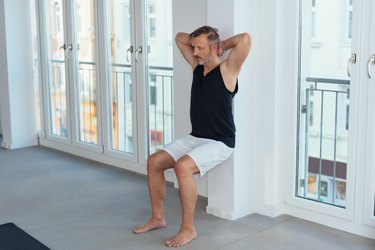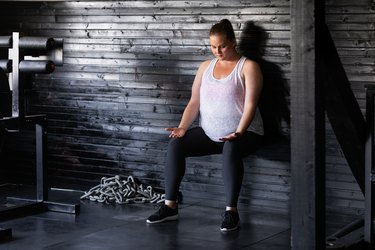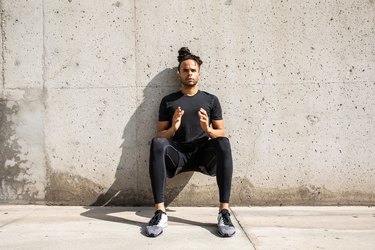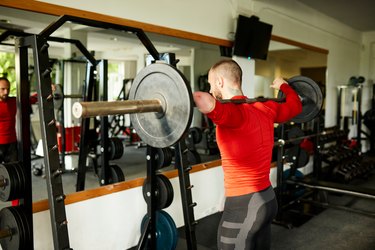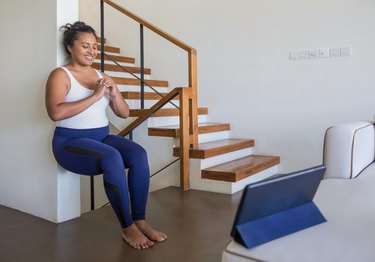
For many of us, wall sits bring back memories of gym class and after-school sports. And while you may have hated them as a teenager, they give your adult self plenty to love.
Wall sits (or wall squqats) help you build greater strength and endurance throughout your lower-body and leg muscles. Because they only require your body weight and a sturdy wall, they're also handy for when you don't have access to equipment or are trying to squeeze in a workout on-the-go. And if you keep your holds nice and easy, you can do wall sits every day.
Video of the Day
- What is a wall sit? The name says it all. It's a lower-body exercise that involves holding a seated position against a wall.
- What muscles does it work? The wall sit is an isometric (stationary) move that works your glutes, quads, hamstrings, abdominals and calves, says Jessica Mazzucco, CPT, a personal trainer in New York City.
- Who can do a wall sit? They're generally safe and effective for building strength and endurance, according to certified personal trainer Tami Smith, CPT, founder of Fit Healthy Momma. However, people with chronic knee or back pain may want to avoid the exercise. "I would also caution those who have trouble getting up from a chair against getting down into position, as it may be difficult to get back up out of it safely," she says.
How to Do a Wall Sit With Perfect Form
Wall Sit
- Stand with your back pressed firmly against a wall and your feet hip-width apart and a foot or two in front of you.
- Keeping your back pressed into the wall, slide down and bend your knees until your thighs are parallel to the floor. Your ankles should be directly under, or in front of, your knees. Place your hands on your lap or in front of your chest. (Don't cheat by pressing your arms into the wall.)
- Tighten your core and press your lower back into the wall. Hold this seated position for as long as possible.
- Once you’re ready to end your set, slide up the wall to return to standing.
Tip
If this move feels too difficult, try placing a stability ball in between your back and the wall. You can also reduce how far you lower.
How Long Should You Wall Sit?
According to the Guinness World Records, the current wall sit record stands at a cool 11 hours, 51 minutes, 14 seconds. But don't worry, you don't have to hold it nearly that long to see benefits. When you're first starting out, aim for 15 to 30 seconds.
But is it better to do more sets of shorter wall sit holds or fewer sets of longer holds? That depends. The ideal time varies according to your fitness level and goal.
How Long to Hold, by Level
Level | Reps | Time |
|---|---|---|
Beginner | 5 | 15 seconds |
Intermediate | 3 | 30 to 60 seconds |
Advanced | 3 | 60+ seconds |
Beginner: It can be best, when getting started, to do more (like 4 or 5) sets of shorter wall sit holds, around 15 seconds. More breaks mean more time for your muscles to rest and recover.
"With proper breaks, people may be able to perform more total seconds of wall sits than if they held fewer until their legs gave out," Mazzucco says.
Intermediate/Advanced: Aim to do 3 sets, holding each for as long as possible — you want to be able to hold longer than 60 seconds.
"Longer holds force the body's muscles to not only strengthen, but increase endurance as well," she says.
Many beginners can hold a wall sit exercise for 30 seconds, while more advanced exercisers can often hold steady for 60 to 90 seconds, Mazzucco says.
How Long to Hold, by Goal
Endurance: As an isometric exercise, the sit is typically ideal for building muscular endurance, or how long your legs can work without fatiguing.
So, if you're trying to shore up the staying power of your legs, Mazzucco suggests doing more sets and either holding each for longer periods of time or cutting back on rest. According to her, a four-week progression may look like this:
- Week 1: 1-minute hold, 1-minute rest; 3 rounds
- Week 2: 1-minute hold, 30-second rest; 3 rounds
- Week 3: 1-minute hold, 30-second rest; 4 rounds
- Week 4: 90-second hold, 30-second rest; 4 rounds
Strength: To build max strength, you'll want to use wall sit progressions (like those below) to increase how hard your muscles work, but in a relatively short amount of time.
For instance, you can do 30-second holds while holding progressively heavier weights. You goal to push yourself to fatigue with each hold. Rest for 1 or 2 minutes between holds.
Tip
Remember that, once you finish your hold, you still have to stand back up. So don't take your sets to complete failure or you'll fall on the floor.
5 Wall Sit Benefits
1. They Build Lower Body Strength and Endurance
What do wall sits do for your body?
First off, holding yourself in a seated position with only a wall to support you challenges your lower body muscles in a big way. Expect some gains in your quads, glutes, hamstrings and calves.
And training your muscles to hold that position for a longer period of time will really hone in on your endurance, Smith says.
2. They Improve Core Stability
Holding that pose also requires — and builds — core strength and stability. Your transverse abdominis, the deepest-lying core muscle, will be the hardest worked.
To up the ante, try a single-leg hold.
3. They Don't Require Any Equipment
One of the benefits of wall sits is you don't need any equipment other than a sturdy wall to prop yourself up. This means you can work your muscles just about anywhere.
You don't even necessarily need equipment once you're ready to advance the exercise. Check out the single-leg variation below to see what we mean.
4. They're Knee-Friendly
For anyone who has trouble with squats or finds them uncomfortable on their knees, the wall sit exercise is a great alternative.
That's both because they're isometric and because they involve sitting back and down, rather than leaning forward over your feet.
5. They Lower Blood Pressure
In a large July 2o23 meta-analysis published in the British Journal of Sports Medicine, researchers found that isometric exercises — specifically wall sits — were the most effective exercise at lowering overall blood pressure.
This builds on an April 2022 study in the British Journal of Sports Medicine that found that isometric exercises in general lower blood pressure better than HIIT.
However, how long to hold a wall sit for improved blood pressure is quite long — 2 minutes. The suggested protocol from the 2023 study is 14-minute sessions, three times a week, with 2-minute holds and 2-minute rests. But if a healthier blood pressure is your goal, it's worth building up to.
2 Progressions to Make Your Wall Sits Harder
Weighted Wall Sit
Weighted Wall Sit
- Grip a dumbbell or kettlebell against your chest with both hands. Stand with your back pressed firmly against a wall and your feet hip-width apart and foot or two in front of you.
- Keeping your back pressed into the wall, slide down and bend your knees until your thighs are parallel to the floor. Your ankles should be directly under, or in front of, your knees. Place your hands on your lap or in front of your chest. (Don't cheat by pressing your arms into the wall.)
- Tighten your abdomen and press your lower back into the wall. Hold this seated position for as long as possible.
- Once you're ready to end your set, slide up the wall to return to standing.
“Extra resistance from weight will up the tension on your muscles,” Smith says. “The more resistance you add, the more your muscles will be forced to work and the better your results will be.”
There are other ways to add weight to the exercise. You could hold a medicine ball, wear a weighted vest or set a weight plate or sandbag on your thighs.
Single-Leg Wall Sit
- Stand with your back pressed firmly against a wall with your feet hip-width apart and foot or two in front of you.
- Keeping your back pressed into the wall, slide down and bend your knees until your thighs are parallel to the floor. Your ankles should be directly under, or in front of, your knees. Place your hands on your lap or in front of your chest. (Don't cheat by pressing your arms into the wall.)
- Tighten your abdomen and press your lower back into the wall. Then, lift one leg off the ground. Hold this seated position for as long as possible.
- Once you're ready to end your set, slide up the wall to return to standing.
- Repeat the move, lifting your opposite leg off the floor.
“We all tend to have a more dominant side, so isolating the muscles on one side of our body forces us to work them without the assistance of the other side,” Smith says.
Plus, single-leg variations challenge both strength and balance. Only attempt this move once you’ve gotten the hang of the two-leg variation.
